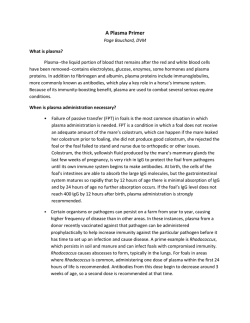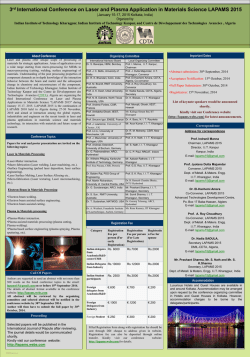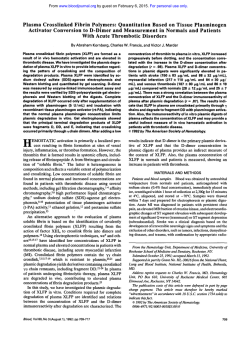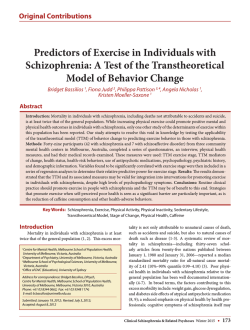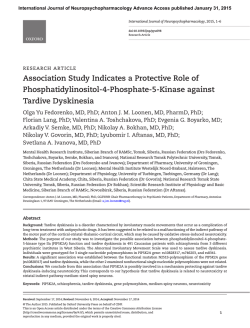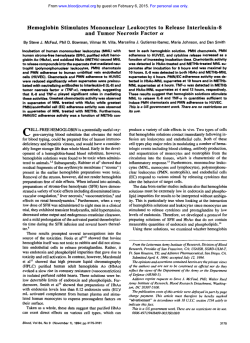
Measuring Adherence to Medication in Schizophrenia
International Journal of Neuropsychopharmacology Advance Access published January 31, 2015 International Journal of Neuropsychopharmacology, 2015, 1–7 doi:10.1093/ijnp/pyu091 Research Article research article Measuring Adherence to Medication in Schizophrenia: The Relationship between Attitudes toward Drug Therapy and Plasma Levels of New-Generation Antipsychotics Nursen Yalcin-Siedentopf, MD; Fabienne Wartelsteiner, MD; Alexandra Kaufmann, MD; Falko Biedermann, MD; Monika Edlinger, MD; Georg Kemmler, PhD; Maria A. Rettenbacher, MD; Christian G. Widschwendter, MD; Gerald Zernig, MD; W. Wolfgang Fleischhacker, MD; Alex Hofer, MD Biological Psychiatry Division (Drs Yalcin-Siedentopf, Wartelsteiner, Kaufmann, Biedermann, Edlinger, Rettenbacher, Widschwendter, Fleischhacker, and Hofer), and General and Social Psychiatry Division (Drs Kemmler and Zernig), Medical University Innsbruck, Department of Psychiatry and Psychotherapy, Innsbruck, Austria Correspondence: Alex Hofer, MD, Medical University Innsbruck, Department of Psychiatry and Psychotherapy, Anichstr. 35, 6020 Innsbruck, Austria ([email protected]). Abstract Background: Nonadherence to medication is still a major problem in the treatment of schizophrenia. The current longitudinal study investigated whether the patients’ attitudes toward treatment correlated with the ratio of observed vs expected plasma levels of antipsychotic drugs as an objective measurement of adherence. Methods: Data of patients starting monotherapy with a new-generation antipsychotic were collected 2, 4, and 12 weeks after the initiation of treatment. Next to the assessment of patients’ attitudes toward medication by means of the Drug Attitude Inventory, the ratio of the observed vs expected plasma level was calculated. Antipsychotic-induced side effects were evaluated by means of the Udvalg for Kliniske Undersogelser Side Effect Rating Scale. Results: A total of 93 patients were eligible for statistical analysis. About one-half of the ratios of observed vs expected plasma levels ranged from 0.5 to 2 and were considered normal, whereas the other ratios were considered either too low (<0.5) or too high (>2). No consistent correlation between patients’ attitude toward drug therapy and the individual ratios of observed vs expected plasma levels of medication was detected. This finding was not affected by side effects. Conclusions: Our results highlight the importance of recognizing the complex nature of adherence to medication in schizophrenia patients. Importantly, we found no consistent correlation between subjective and objective measures of medication adherence. Therefore, monitoring adherence to medication remains a challenge in clinical practice. Keywords: schizophrenia, adherence, therapeutic drug monitoring, drug attitude, ratio Received: August 1, 2014; Revised: October 13, 2014; Accepted: October 30, 2014 © The Author 2015. Published by Oxford University Press on behalf of CINP. This is an Open Access article distributed under the terms of the Creative Commons Attribution Non-Commercial License (http://creativecommons.org/licenses/by-nc/4.0/), which permits non-commercial re-use, distribution, and reproduction in any medium, provided the original work is properly cited. For commercial re-use, please contact [email protected] 1 2 | International Journal of Neuropsychopharmacology, 2015 Introduction In spite of promising advances in antipsychotic treatment, nonadherence to medication remains a common problem in patients suffering from schizophrenia that is largely independent of the type (first vs new generation) or the formulation (oral vs longacting injectable) of drugs (Hofer and Fleischhacker, 2014). Most experts define full adherence as taking 80% or more of the prescribed medication and accordingly, about 50% of patients have been reported to be partially or nonadherent (Velligan et al., 2009). Next to poor insight into the illness, negative attitudes toward medication and adverse effects of antipsychotics (Brain et al., 2013), lack of social support, cognitive deficits, and a poor therapeutic alliance (Acosta et al., 2012) have been shown to be strong predictors for nonadherence, which, in turn, is associated with an increased risk of relapse, rehospitalization, and antipsychotic treatment resistance on one hand and with substance use, violence, arrests, suicide attempts, and impaired long-term functioning on the other (Hofer and Fleischhacker, 2011). Depending on the different assessment methods used, reported average adherence rates for schizophrenia patients vary widely, that is, between 10 and 90% (Sacchetti and Vita, 2014). Subjective methods like self-reports and physician reports are most commonly used (Velligan et al., 2009); however, they frequently underestimate the degree of nonadherence (Sacchetti and Vita, 2014). Using objective methods like pill counting, electronic monitoring, or measuring plasma levels may enhance the chance of detecting adherence problems, but none of these methods can reflect the dosage actually ingested by the patient. To expand on previous research, the current study aimed to investigate the correlation between simultaneously applied subjective and objective measures of medication adherence. To this end, schizophrenia patients starting monotherapy with a newgeneration antipsychotic drug (NGA) in a naturalistic treatment setting were prospectively followed up for 3 months. Using a self-report questionnaire, we assessed the patients’ subjective response and attitudes toward medication as an indirect indicator of adherence and investigated whether it is related to the ratio of the observed vs expected plasma levels of the NGA. This approach was chosen to account for inter- and intra-individual variability in drug levels and to provide a rough approximation of the dosage actually ingested. In addition, we investigated the possible influence of antipsychotic-induced side effects in this context. Methods In- and outpatients fulfilling the diagnostic criteria for schizophrenia spectrum disorders according to ICD-10 between the ages of 18 and 65 years were included into a prospective, naturalistic study after having signed written informed consent in accordance with the local ethics committee. They did not suffer from any other axis I disorders, including substance use. Diagnoses were confirmed using chart information and reports from clinicians who had treated these patients. Patients who had been pretreated with antipsychotics and in whom a switch was indicated because of insufficient efficacy or intolerance underwent a washout period of 3 to 5 days. Taking more than one antipsychotic or treatment with a long-acting injectable antipsychotic were exclusion criteria. Antipsychotics were chosen by the treating psychiatrists, dosing followed clinical needs. Benzodiazepines were permitted to treat agitation, anxiety, or sleep disturbances and biperiden/propranolol for extrapyramidal symptoms and akathisia. At baseline, sociodemographic and clinical data were obtained. Psychopathology was rated by means of the Positive and Negative Syndrome Scale (PANSS; Kay et al., 1987). Follow-up visits were conducted after 2, 4, and 12 weeks of treatment. Patients were asked to fill out the 30-item version of the Drug Attitude Inventory (DAI; Hogan et al., 1983). A psychiatrist belonging to a trained schizophrenia research team conducted the PANSS rating and quantified side effects using the Udvalg for Kliniske Undersogelser (UKU) Side Effect Rating Scale (Lingjaerde et al., 1987). The relationship between PANSS data and plasma levels will be the subject of a future report. The DAI assesses the patients’ subjective response to antipsychotics and their attitudes toward medication. It is divided into 7 factors: (1) subjective positive feelings related to antipsychotics, (2) subjective negative feelings attributed to the drugs, (3) health/illness-dependent drug intake: patients’ model of health, (4) patients’ confidence in physician, (5) control: patients’ attitudes toward the locus of control in taking medication, (6) prevention: patients’ belief in the effect of antipsychotics in forestalling relapse, and (7) harm: patients’ concerns with potential toxic effects. The raw subscores of the DAI were converted to a range from 0 to 100 by linear transformation. In addition, a compliance subscore ranging from 0 to 10 was calculated according to the instructions of the developers. The UKU Side Effect Rating Scale comprises a total of 48 symptoms arranged into 4 groups: psychic, neurological, autonomic, and other side effects. Each symptom is scored on a severity scale from 0 to 3, and the rater assesses whether the report is best attributed to a side effect (rated as improbable, possible, or probable) or related to the disease. Adverse effects with scores ≥1 on any UKU item and a causal relationship of possible or probable were considered as antipsychotic-induced side effects. At each follow-up visit, a blood sample was taken, and the concentration of the antipsychotic medication in the blood plasma was measured by the ISO 9001-certified psychiatric laboratory using high performance liquid chromatography-tandem mass spectrometry. Blood sampling was conducted before breakfast and before the morning medication, usually at around 8 am. The expected plasma level of the specific antipsychotic medication the patient received was calculated using AutoKinetic®, version 3.4 (Toennes, 2000). This software is a Microsoft Excel-based pharmacokinetic simulation program developed by Dr. Stefan W. Toennes at the Institute of Legal Medicine at the Goethe University, Frankfurt/Main, Germany and can be obtained together with a user’s manual directly from the author of Autokinetik (toennes@ em.uni-frankfurt.de). Autokinetik allows the calculation of individual expected plasma concentration levels for any medication, has been recommended for therapeutic drug monitoring (TDM; Hiemke et al., 2011), and has even been successfully used to model brain and plasma levels under animal experimental conditions (Crespo et al., 2005). The required data are the patient’s body weight, the period of time to be calculated, and the exact treatment regimen (ie, the prescribed dose and time of intake). In addition, the following pharmacokinetic data are entered: volume of distribution, t-max (= time required for the antipsychotic drug to reach its peak [ie, maximum] concentration), terminal elimination half-life, and bioavailability. To emphasize, the advantage of Autokinetic® over more general pharmacokinetics software or equations given in pharmacology textbooks (e.g., Brunton et al., 2006) is that each dose administered and each time of intake are considered in the calculation of the expected values, allowing for a precise prediction of the expected values at all imaginable doses and dosing intervals. When calculating values on Yalcin-Siedentopf et al. | 3 the basis of known doses and pharmacokinetics data taken, for example, from standard pharmacology textbooks and comparing these values with the values calculated by Autokinetic®, a perfect match is obtained (not shown). Pharmacokinetic data of each drug were obtained from the psychiatric laboratory. The difference between the half-life of olanzapine in males (32 hours) and females (37 hours) was considered in the calculations. The expected plasma level concentrations of risperidone and its active metabolite, 9-hydroxyrisperidone, were separately calculated and added. As there exists a large range in the half-life of clozapine (6–26 hours), a value of 12 hours was used for the calculations. The expected plasma level concentrations used for statistical analysis were steady-state values. However, if the blood sample was taken before steady state had been reached due to changes in medication dosage days prior to blood sampling, we took the expected blood plasma level value on the day of blood sampling, which was calculated using AutoKinetic®. To account for inter- and intra-individual variability, ratios of observed vs expected plasma levels ranging from 0.5 to 2 were considered as normal, whereas ratios ranging from 0 to 0.499 were considered as too low and ratios >2 as too high. A too-low ratio means that the expected plasma level is higher than the observed plasma level of the antipsychotic drug measured, indicating suboptimal adherence and/or faster-than-average elimination of the medication. A too-high ratio, in turn, means that the expected plasma level is lower than the observed plasma level, indicating that lower-than-average elimination of the medication and/ or overadherence, that is, nonprescribed surplus intake by the patient (Zernig et al., 2009; Hiemke et al., 2011). Analysis of Data and Statistical Methods Only those patients were included in the statistical analysis for whom both the ratio of observed vs expected plasma levels and the DAI were available for at least 1 of the 3 assessment times (weeks 2, 4, and 12 of treatment). All statistical analyses were performed using SPSS (version 20). As the majority of the variables involved showed departures from a normal distribution, nonparametric statistical tests were used throughout the analysis. The time course of the ratio and of the DAI was analyzed by means of the Friedman test (comparison of all 3 time points) and the Wilcoxon test (pairwise comparison of time points). The McNemar test was employed to test for significant changes of side effects in the course of time (side effects assessed by the UKU were coded as 0 = no, 1 = yes). The Spearman rank correlation was used to analyze associations between the subscales of the DAI and the ratio of observed vs expected plasma levels. The same method was also used to analyze associations between the ratio and side effects assessed by the UKU. All statistical tests were performed at a 5% level of significance. To limit the possibility of a chance finding in the correlation tables and other large sets of variables, these were subjected to a Bonferroni correction (p-value multiplied by the number of tests conducted). Results Sample Characteristics Demographic and clinical characteristics of the study sample are summarized in Table 1. Data of 93 patients were available for baseline analysis. They had a mean age of 36 years and a mean duration of illness of 7.6 years. About two-thirds of participants were male and baseline symptomatology was mild. All patients started monotherapy with an NGA. Patients’ Attitudes toward Medication over the Course of Time (DAI) Table 2 gives an overview of the DAI subscales over the course of time. There were no significant differences between the 3 assessment times for any of the DAI subscales. Overall, patients achieved a relatively high DAI total score (mean value >75) at all 3 observation times. Furthermore, the subscales “subjective positive feelings,” “prevention,” and “confidence in physician” showed high mean values, reflecting the patients’ rather positive attitude toward medication in general. Accordingly, the subscales “subjective negative feelings,” “control,” “harm,” and “health-/illness dependent drug intake” had relatively low scores, which points to the same direction. Lastly, a high DAI compliance subscore (>7) was observed. Ratio of Observed vs Expected Plasma Levels A total number of 218 ratios was available for analysis. Of these, 36.3% had been collected in the inpatient setting. More than one-half of the ratios (50.5%, N = 110) were between 0.5 and 2 and thus considered normal, 35.3% (N = 77) of the ratios were <0.5, and 14.2% (N = 31) were >2, which was considered rather too low or too high, respectively. A ratio of 0, indicating total nonadherence, was observed in only 2 cases. These 2 patients had a ratio of 0 only once, whereas they presented with normal ratios (0.5–2) at the other 2 assessment points. Very large ratios were also rare: 2 values were >10 and another 4 values >5. An overview of the time course of the ratio of observed vs expected plasma levels is given in Table 3. Although the mean ratio slightly decreased from 1.14 after 2 weeks to 0.98 after 12 weeks of treatment, this difference did not reach statistical significance. Association between Attitude toward Medication (DAI) and the Ratio of Observed vs Expected Plasma Levels The associations between DAI subscores and the ratio of observed vs expected plasma levels are shown in Table 4. Table 1. Patient Characteristics (n = 93) Age, mean ± SD, years Gender, N (%), male/female Duration of illness, mean ± SD, y PANSS score, mean ± SD Total score Positive symptoms Negative symptoms General symptoms Antipsychotic treatment, N (%) Amisulpride Aripiprazole Clozapine Olanzapine Quetiapine Risperidone Sertindole Ziprasidone 36.0 ± 10.3 59 (63.4) / 34 (36.6) 7.6 ± 7.3 65.9 ± 19.1 14.5 ± 5.7 18.2 ± 6.8 33.3 ± 9.4 21 (22.7) 4 (4.3) 13 (14.0) 15 (16.1) 13 (14.0) 10 (10.8) 2 (2.2) 15 (16.1) Abbreviation: PANSS, Positive and Negative Syndrome Scale. 4 | International Journal of Neuropsychopharmacology, 2015 Table 2. DAI: Overview and Change over Time Assessment Time DAI total score DAI subjective positive feelings DAI subjective negative feelings DAI confidence in physician DAI prevention DAI control DAI harm DAI health-/illness dependent drug intake DAI compliance subscore# (0–10) Week 2 N = 71-74a Week 4 N = 77-79a Week 12 N = 44-45a Mean SD Mean SD Mean SD 76.9 66.8 22.4 92.5 92.4 8.9 24.3 34.9 7.45 18.7 33.2 26.1 23.1 21.7 25.5 35.3 36.4 2.21 77.4 64.2 18.2 90.1 94.9 5.6 21.9 34.6 7.39 18.2 35.6 23.1 27.9 18.9 21.0 34.5 30.5 2.10 77.8 67.1 21.1 92.2 95.6 3.3 20.0 31.1 7.43 76.9 66.8 22.4 92.5 92.4 8.9 24.3 34.9 2.14 Abbreviation: DAI, Drug Attitude Inventory. a The number of valid cases differed between the individual subscales of the DAI due to the fact that there were slight differences in the number of missing cases per DAI item. b Note that except for the DAI compliance subscore which has values ranging from 0 to 10, all subscales have values ranging from 0 to 100. Table 3. Time Course of the Ratio of Observed vs Expected Plasma Levels Assessment Time N Mean SD Median Week 2 Week 4 Week 12 88 81 49 1.14 1.08 0.98 1.31 1.48 0.87 0.80 0.63 0.65 No significant change over the course of time. Overall, there was only a small number of significant or trend level correlations. Notably, all significant or near-significant tests yielded an inverse correlation, indicating that higher ratios of observed vs expected plasma levels went along with a less positive drug attitude. This also applied to the DAI compliance score at week 2 and, at a trend level, at week 4. A significant negative correlation with the ratio was also seen for the DAI subscale “confidence in physician” at week 4. Trend-level significance (p < .1) was found for the subscale “subjective positive feelings” at all observation times and for the DAI total score at weeks 2 and 4. None of the significances were retained after Bonferroni correction for multiple testing (pBonferroni > .1). The treatment setting (in- vs outpatient setting) was associated with neither DAI scores (total score and subscores, respectively) nor with the ratios (too low, normal, too high). Side Effects over the Course of Time Table 5 shows the frequency of side effects recorded with a severity level of at least 1 on the UKU Side Effect Rating Scale. Only symptoms that were noted as a possible side effect by the rater and only those that occurred in >20% of cases are listed. The most common side effect reported at week 2 was concentration difficulties, which decreased over the course of time from 65.5% at week 2 to 43.4% at week 12. This decrease attained statistical significance (p = .021); however, significance was not retained after Bonferroni correction. Concentration difficulties, sedation, extrapyramidal side effects, and amenorrhea in female patients consistently decreased, whereas weight gain consistently increased over the course of the study, but not in a statistically significant quantity. Role of Side Effects on View of the Relation between Attitude toward Medication and Ratio of Observed vs Expected Plasma Levels To find out whether side effects assessed by the UKU explain the negative correlations between DAI subscores and the ratio of observed vs expected plasma levels (shown in Table 4), we investigated the associations between those UKU items that have consistently been found to affect medication adherence (sedation, weight gain, extrapyramidal side effects, and sexual side effects) and the ratio of observed vs expected plasma levels. However, analysis by Spearman correlation coefficients did not reveal any significant associations between the above-mentioned UKU items and the ratio at any of the 3 observation times. Discussion To the best of our knowledge, this is the first study considering both observed and expected plasma levels of NGA to measure adherence to medication in patients with schizophrenia. Of note, no consistent correlation between patients’ attitude toward drug therapy and the ratio of observed vs expected plasma levels of medication was detected. This is in line with previous studies investigating the relationship between different measures of medication adherence (Sacchetti and Vita, 2014). Generally, a positive attitude toward medication has been suggested to be an indirect indicator of adherence (Hogan et al., 1983). In this context, patients who have a good alliance with their doctor have been reported to be more likely to adhere to treatment and achieve better outcomes (Cañas et al., 2013). Accordingly, very high scores on the DAI subscales “prevention” and “confidence in physician” and a high DAI compliance subscore indicate that adherence to medication was remarkably high in our sample, which would be in contrast to studies that have reported approximately 60% of patients with schizophrenia to be nonadherent early in treatment (Offord et al., 2013). A possible explanation for this discrepancy may be that only patients with a generally good attitude toward medication and those who had confidence in their doctors agreed to take part in the study. In addition, adherence is known to be higher among study samples than in routine care (Kane et al., 2013). Yalcin-Siedentopf et al. | 5 Table 4. Correlation between DAI (Sub)Scales and Ratio of Observed vs Expected Plasma Levels Assessment Time DAI (sub)scale Week 2 N = 71-74a Week 4 N = 77-79a Week 12 N = 44-45a Total score Subjective positive feelings Subjective negative feelings Confidence in physician Prevention Control Harm Health-/illness dependent drug intake Compliance subscore -0.222# (P = .078)b -0.218# (P = .083) 0.041 -0.029 0.101 -0.040 0.086 0.107 -0.283* (P = .020) - 0.193# (P = .096) -0.198# (P = .088) -0.037 -0.268* (P = .017) -0.174 0.117 0.168 0.091 -0.205# (P = .075) -0.223 -0.299# (P = .068) -0.012 -0.022 0.207 -0.248 -0.160 0.229 -0.224 Abbreviation: DAI, Drug Attitude Inventory. Spearman rank correlation coefficient. * P < .05. # P < .10 (trend-level significance). a The number of valid cases differed between the individual DAI subscales as there were slight differences in the number of missing cases per DAI item. Moreover, these numbers were smaller than those in Table 2, as the corresponding values of the ratio of observed vs expected plasma level were not always available b Note that P-values were denoted only when significance or trend-level significance was attained Table 5. The Frequency of Side Effects Recorded with a Severity Level ≥1 on the UKU Side Effect Rating Scale Week 2 N = 82 Week 4 N = 81 Week 12 N =53 Side Effect % % % Concentration difficulties Asthenia Sedation Extrapyramidal side effectsa Weight gain Functional sexual disturbancesb Diminished sexual desire Amenorrhea (females) 65.5 48.8 31.0 56.6 24.7 30.4 43.4 34.5 50.0 51.3 30.9 50.6 25.6 21.5 48.1 22.2 43.4* 50.9 26.4 41.5 34.0 31.3 41.5 15.4 Significantly lower than at week 2 (P = .021, McNemar test). Significance is not retained after Bonferroni correction for multiple testing. Dystonia, rigidity, hypokinesia/akinesia, hyperkinesia, tremor, akathisia b Erectile dysfunction, ejaculatory dysfunction, orgastic dysfuntion, dry vagina. * a Similar to previous studies, this limits the generalizability of the collected data. One-half of the patients had ratios of observed vs expected plasma levels ranging from 0.5 to 2, indicating that they had been taking their medication as prescribed. The ratios in the remaining patients were considered as either too low or too high, suggesting an aberrant medication intake and/or that the patients eliminated them faster or more slowly than average. However, these findings should be interpreted with some caution. Due to inter-individual pharmacokinetic differences caused by age, concurrent diseases, concomitant medication, or genetic peculiarities and intra-individual variability caused by lifestyle activities such as smoking and caffeine use, it remains challenging to interpret and generalize the results of TDM (Velligan et al., 2007; Hiemke et al., 2011). Also, blood sample collection represents a “snapshot in time” (Mattson, 1995). Although AutoKinetic® is a very efficient program in calculating expected plasma levels of different drugs, it does not take into account the different activities of drug metabolizing enzymes. Therefore, plasma levels being lower than the expected result may indicate either that a patient has not been taking the medication as prescribed in the days prior to blood sampling and/or that he/she metabolizes/eliminates the medication faster than average. On the other hand, plasma levels being higher than the expected result may indicate that a patient took the medication shortly before blood sampling, that he/she is a poor metabolizer, and/or that he/she takes more medication than prescribed. Notably, treatment with risperidone allows identification of those patients who have taken their medication shortly before blood sampling by yielding a high risperidone-to-9-hydroxyrisperidone ratio (Zernig et al., 2009). Concordance of the observed and the expected plasma level may indicate that a patient adheres to drug treatment; however, this result is also found in the case of both suboptimal adherence but slower-than-average elimination or overadherence, ie, surplus intake by the patient, and faster-than-average elimination. Significant correlations between DAI subscores and the ratio of observed vs expected plasma levels were only found for the DAI compliance subscore at week 2 and for the subscale “confidence in physician” at week 4. In both cases, lower DAI subscores correlated with higher ratios. However, given the weak correlations, it cannot be ruled out that this is a chance finding. Further studies addressing this issue are clearly warranted. Continuously updated guidelines for the use of plasma level determinations, that is, TDM, including recommended therapeutic blood levels, are available (Hiemke et al., 2011). TDM is based on the assumption that a correlation between plasma levels and therapeutic effects, side effects, and toxicity can be established. Regarding the occurrence of side effects associated with NGAs, positive correlations between therapeutic 6 | International Journal of Neuropsychopharmacology, 2015 effect and plasma levels have been demonstrated for amisulpride (Sparshatt et al., 2009), aripiprazole (Sparshatt et al., 2010), olanzapine (Perry et al., 2005), and risperidone (Yasui-Furukori et al., 2010; Yasui-Furukori et al., 2011). Furthermore, a number of studies have reported on the negative impact of antipsychotic-induced side effects on adherence (Dibonaventura et al., 2012; Marder, 2013; Haddad et al., 2014; Hofer and Fleischhacker, 2014). In our study, side effects were associated with neither the patients’ attitudes toward drug therapy nor the ratio of observed vs expected plasma levels. This is in line with our previous studies (Hofer et al., 2002; Rettenbacher et al., 2004; Hofer et al., 2007) and can be interpreted as the consequence of intensive efforts to actively ascertain side effects and to respond to patients’ concerns quickly, which has been shown to improve the therapeutic relationship and thereby indirectly enhance adherence (Marder, 2005; Higashi et al., 2013). The naturalistic design of this study also constitutes a limitation. Patients were aware from the start that the purpose of this study was to evaluate adherence to medication and to compare the different measures with each other. It is therefore probable that patients who were generally adherent were more likely to agree to participate, whereas patients with adherence problems declined to take part. Unfortunately, we did not record the number of patients who refused to participate. In addition, it was not possible to include involuntarily committed patients, who are generally considered as seriously ill, as it is forbidden by law to do so in Austria. This can be seen by the relatively low mean PANSS total score at baseline, which indicates a group of patients with mild symptomatology. Similar to other studies, these factors point to a possible selection bias. On the other hand, the naturalistic design comprising few exclusion criteria and the consideration of both observed and expected plasma levels makes our data relevant for everyday clinical practice. It will be critical to conduct further studies in larger samples involving patients who are less adherent to treatment than those who were included in the current study as well and ideally to focus on single substances or substance classes. To summarize, the findings of the current study reaffirm that monitoring adherence to medication remains a challenge in clinical practice. As each method has advantages as well as disadvantages, it is up to the attending psychiatrist to play an active role in identifying and minimizing the factors that may lead to nonadherent behavior and to strengthen those factors promoting adherence in each individual patient. Statement of Interest The authors declare no conflict of interest related to the subject of this report. Dr. Yalcin-Siedentopf has received reimbursement for travel and meeting expenses from Janssen-Cilag and AOP Orphan. Dr. Kaufmann has received reimbursement for travel, accommodation, and meeting expenses from AstraZeneca, BMS, Eli Lilly, Janssen-Cilag, Pfizer, Lundbeck, and AOP Orphan. Dr. Edlinger has received reimbursement for travel and meeting expenses from Pfizer. Dr. Rettenbacher has received compensation as a member of the scientific advisory board of Eli Lilly. Dr. Widschwendter has received reimbursement for travel and meeting expenses from AOP Orphan. Dr. Zernig has received speaker’s or consultancy fees or unrestricted educational grants or support for the execution of scientific conferences from AlcaSynn, AstraZeneca, Bio-Rad, Bristol-Myers Squibb, Eli Lilly, Kwizda, Janssen-Cilag, Lundbeck, Mundipharma, Novartis, Nycomed, Pfizer, and Wyeth. He has held compensated yet unrestricted lectures on problems of TDM for AstraZeneca, Bristol-Myers Squibb, Eli Lilly, GlaxoSmithKline, Janssen-Cilag, Lundbeck, and Pfizer. Dr. Fleischhacker has received research grants from Janssen-Cilag, Otsuka, Pfizer, and Reckitt-Benckiser. He has received speaker’s or consultancy fees from BMS, Endo, Janssen-Cilag, Lundbeck, MedAvante, Otsuka, Pfizer, Richter, Roche, Sunovion, Takeda, and Vanda. He holds stocks of MedAvante. Dr. Hofer has received a research grant from Janssen-Cilag. He has received speaker’s or consultancy fees from BMS, Janssen-Cilag, and Lundbeck. He has received reimbursement for travel and meeting expenses from AOP Orphan, Janssen-Cilag, Lundbeck, Pfizer, and Roche. Dr. Wartelsteiner, Dr. Biedermann, and Dr. Kemmler have no interests to declare. References Acosta FJ, Hernández JL, Pereira J, Herrera J, Rodríguez CJ (2012) Medication adherence in schizophrenia. World J Psychiatry 2:74–82. Brain C, Allerby K, Sameby B, Quinlan P, Joas E, Karilampi U, Lindström E, Eberhard J, Burns T, Waern M (2013) Drug attitude and other predictors of medication adherence in schizophrenia: 12 months of electronic monitoring (MEMS®) in the Swedish COAST-study. Eur Neuropsychopharmacol 23:1754–1762. Brunton LL, Lazo JS, Parker KL, eds (2006) Goodman & Gilman’s The pharmacological basis of therapeutics. New York: McGraw-Hill. Cañas F, Alptekin K, Azorin JM, Dubois V, Emsley R, García AG, Gorwood P, Haddad PM, Naber D, Olivares JM, Papageorgiou G, Roca M (2013) Improving treatment adherence in your patients with schizophrenia: the STAY initiative. Clin Drug Investig 33:97–107. Crespo JA, Sturm K, Saria A, Zernig G (2005) Simultaneous intraaccumbens remifentanil and dopamine kinetics suggest that neither determines within-session operant responding. Psychopharmacology 183:201–209. Dibonaventura M, Gabriel S, Dupclay L, Gupta S, Kim E (2012) A patient perspective of the impact of medication side effects on adherence: results of a cross-sectional nationwide survey of patients with schizophrenia. BMC Psychiatry 12:20. Haddad PM, Fleischhacker WW, Peuskens J, Cavallaro R, Lean ME, Morozova M, Reynolds G, Azorin JM, Thomas P, Möller HJ (2014) SMARTS (Systematic Monitoring of Adverse events Related to TreatmentS): The development of a pragmatic patient-completed checklist to assess antipsychotic drug side effects. Ther Adv Psychopharmacol 4:15–21. Hiemke C, Baumann P, Bergemann N, Conca A, Dietmaier O, Egberts K, Fric M, Gerlach M, Greiner C, Gründer G, Haen E, Havemann-Reinecke U, Jaquenoud Sirot E, Kirchherr H, Laux G, Lutz UC, Messer T, Müller MJ, Pfuhlmann B, Rambeck B, Riederer P, Schoppek B, Stingl J, Uhr M, Ulrich S, Waschgler R, Zernig G (2011) AGNP consensus guidelines for therapeutic drug monitoring in psychiatry: update 2011. Pharmacopsychiatry 44:195–235. Higashi K, Medic G, Littlewood KJ, Diez T, Granström O, De Hert M (2013) Medication adherence in schizophrenia: factors influencing adherence and consequences of nonadherence, a systematic literature review. Ther Adv Psychopharmacol 3:200–218. Hofer A, Kemmler G, Eder U, Honeder M, Hummer M, Fleischhacker WW (2002) Attitudes toward antipsychotics among outpatient clinic attendees with schizophrenia. J Clin Psychiatry 63:49–53. Hofer A, Rettenbacher MA, Edlinger M, Kemmler G, Widschwendter CG, Fleischhacker WW (2007) Subjective response and attitudes toward antipsychotic drug therapy during the initial treatment period: a prospective follow-up study in patients with schizophrenia. Acta Psychiatr Scand 116:354–361. Yalcin-Siedentopf et al. | 7 Hofer A, Fleischhacker WW (2011) Compliance with treatment and its relevance for the management of schizophrenia. Hot Topics Neurol Psychiatry 11:7–13. Hofer A, Fleischhacker WW (2014) Pharmacological strategies to enhance adherence in schizophrenia. In: Adherence to antipsychotics in schizophrenia. (Sacchetti E, Vita A, Siracusano A, Fleischhacker WW, eds) pp85–97. Italia: Springer. Hogan TP, Awad AG, Eastwood R (1983) A self-report scale predictive of drug compliance in schizophrenics: reliability and discriminative validity. Psychol Med 13:177–183. Kane JM, Kishimoto T, Correll CU (2013) Non-adherence to medication in patients with psychotic disorders: epidemiology, contributing factors and management strategies. World Psychiatry 12:216–226. Kay SR, Fiszbein A, Opler LA (1987) The Positive and Negative Syndrome Scale (PANSS) for schizophrenia. Schizophr Bull 13:261–276. Lingjaerde O, Ahlfors UG, Bech P, Dencker SJ, Elgen K (1987) The UKU Side Effect Rating Scale - a new comprehensive rating scale for psychotropic drugs and a cross-sectional study of side effects in neuroleptic-treated patients. Acta Psychiatr Scand 334:1–100. Marder SR (2005) Subjective experiences on antipsychotic medications: synthesis and conclusions. Acta Psychiatr Scand Suppl 427:43–46. Marder SR (2013) Monitoring treatment and managing adherence in schizophrenia. J Clin Psychiatry 74:e21. Mattson RH (1995) Antiepileptic drug monitoring: a reappraisal. Epilepsia 36 Suppl 5:S22–29. Offord S, Lin J, Mirski D, Wong B (2013) Impact of early nonadherence to oral antipsychotics on clinical and economic outcomes among patients with schizophrenia. Adv Ther 30:286–297. Perry PJ, Argo TR, Carnahan RM, Lund BC, Holman TL, Ellingrod VL, Miller D (2005) The association of weight gain and olanzapine plasma concentrations. J Clin Psychopharmacol 25:250–254. Rettenbacher MA, Hofer A, Eder U, Hummer M, Kemmler G, Weiss EM, Fleischhacker WW (2004) Compliance in schizophrenia: psychopathology, side effects, and patients’ attitudes toward the illness and medication. J Clin Psychiatry 65:1211–1218. Sacchetti E, Vita A (2014) Poor adherence to antipsychotic medication in people with schizophrenia: diffusion, consequences and contributing factors (Sacchetti E, Vita A, Siracusano A, Fleischhacker WW, eds) pp1–84. Italia: Springer. Sparshatt A, Taylor D, Patel MX, Kapur S (2009) Amisulpride – dose, plasma concentration, occupancy and response: implications for therapeutic drug monitoring. Acta Psychiatr Scand 120:416–428. Sparshatt A, Taylor D, Patel MX, Kapur S (2010) A systematic review of aripiprazole – dose, plasma concentration, receptor occupancy, and response: implications for therapeutic drug monitoring. J Clin Psychiatry 71:1447–1456. Toennes SW (2000) Pharmacokinetic simulations for forensic toxicological evaluation and expertise. Toxichem + Krimtech 67:81–90. Velligan DI, Wang M, Diamond P, Glahn DC, Castillo D, Bendle S, Lam YW, Ereshefsky L, Miller AL (2007) Relationships among subjective and objective measures of adherence to oral antipsychotic medications. Psychiatr Serv 58:1187–1192. Velligan DI, Weiden PJ, Sajatovic M, Scott J, Carpenter D, Ross R, Docherty JP (2009) The expert consensus guideline series: adherence problems in patients with serious and persistent mental illness. J Clin Psychiatry 70:1–46. Yasui-Furukori N, Saito M, Nakagami T, Furukori H, Suzuki A, Kondo T, Kaneko S (2010) Clinical response to risperidone in relation to plasma drug concentrations in acutely exacerbated schizophrenic patients. J Psychopharmacol 24:987– 994. Yasui-Furukori N, Tsuchimine S, Saito M, Nakagami T, Sugawara N, Fujii A, Kaneko S (2011) Comparing the influence of dopamine D2 polymorphisms and plasma drug concentrations on the clinical response to risperidone. J Clin Psychopharmacol 31:633–637. Zernig G, Hiemke C, Havemann-Reinecke U, Laux G, Riederer P, Rabl W, Iten PX, Battista HJ, Eckermann G, Eusterschulte B, Kriechbaum N, Kuss H, Lehofer M, Müller H, Nienhusmeier M, Prunnlechner R, Schoppek B, Schwarz M, Stetter R, Venier A, Kauert G, Saria A (2009) Empfehlungen für die gutachterliche Bewertung von Medikamentenspiegeln in der Psychiatrie im gerichtsanhängigen Schadensfall. Psychopharmakotherapie 2:57–65.
© Copyright 2025
